
Inside Scott Base
This page is all about the inside of Scott Base. Its hard to show every little detail because the base has got so many nooks and cranys that are used to the maximum, it becomes hard to get a picture of everything. Even the corridore linkways which go between buildings have totoaly differnt personalitys. For those of you who have "walked the walk" from one end of the base to the other , I hope these pictures bring back memeories no matter how much the base place has changed since you where here last. For those of you new to the place,.... let me give you a brief descritption of the rooms as we go. I suggest you use both this page and the one which shows the outside of the Base to get a better picture of where you are.
For those of you who either first enter the Base (bright eyed and bushy tailed) or when you finaly leave the base (sad and wishing you could stay longer) this is may be the first or last part of the place you will ever see. It is the main entrance for Scott Base personnel. Not normaly used by visitors which are meant to enter around the front of the building. This entrance is in the linkway between the garage and the workshops. If you walk straight ahead you walk into the engineering workshop and if you walk back into the camera, you walk into the garage.

The garage. This is just the workbech area. you will find everything from D8s to cars, motorbike and hagglunds have been repaired and modified in this place. The foor is made of interlinking concrete slabs prefabricated in New Zealand with a very high load rateing. The foor is on piles above the ground to alow snow to be blown underneath rather than collect and build up..... Or thats the theory. The whole Base is built on piles and the theory of wind blowing underneath works in some areas but not others. In our year the mechanic decided the floor was to cold so he put snow around the base of the building to stop air flow under the building carrying the heat away. It seemed to work compared to other years when mechanics had complianed of bitterly cold floors. One end of the workshop is dedicated to a cold porch area. That means there are another set of doors between the main outside doors and the main workshop. vehicles have a chance to shed the snow and ice before getting into the main workshop, and when one of the big doors is opened you dont lose all the heat out of the main worshop erea.
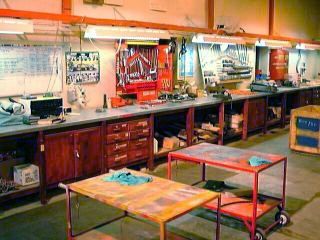
The carpentry workshop has to be another one of the colder places on the base durring certain wind conditions. Unlike the Garage, its big external door leads directly to the outside of the base and offers very little thermal protection. However it has one main advantage. Its must have one of the best worshop views in the world. Its windows face directly to Mt Eribus and if there are any unusual sky condintions then you get to see them all. The workshop equipment is designed more for an advanced home handyman and was never designed to be a large scale prefabrication workshop.... However, I think thats what they expect of it in todays comercial environment.

The Engineering workshop is another advanced home handyman setup, used for engineering and plumbing alike. It has most of the tools required to do the job around the base, and for anything we cant handle, then we go over to the McMurdo base and ask for thier assistance. The workshops at McMurdo are fully commercial instillations and they often have a bigger problem trying to staff them with people suitably qualified to run the equipment.

This was my workshop for 12 months. It seves as an electrical workshop, electrical day store, fire equipment maintnenance worshop and office. It often went from being tidy to messy within the blink of an eye.
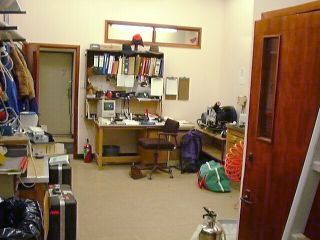
The base is run by an electrical generator. Thier are three of them on the base. Two in the upper main power house and one in the lower power house. Only one required to be run at any one time. Rated at about 180 KVA (they have been modified slightly and nobody seems to know exactly what they are capable of). 400volts between phases and 230 volts to earth.
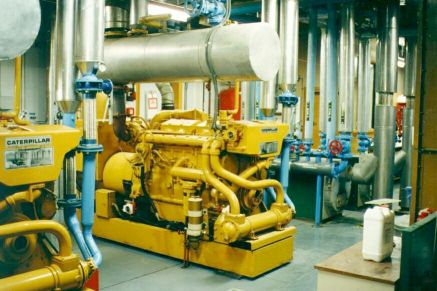
The fresh water is produced by a reverse osmossis plant which removes the salt from sea water. It works similar to a sieve but its actual operating charachteristics are slightly different. It uses high water presure and microscopic membrances to achieve an effect of pure water WANTING to seperate from salt water. All a bit intelectual untill you get your head around the concepts. Read a book about it if your interested. Anyway it works OK and for real fresh water they put the drinking water through a second stage to make sure its very pure. So pure its almost not good for you. In McMurdo they have to put addiditives back into the water to stop pipes from leaching lead and the human body from leaching calcium and other trace elements.
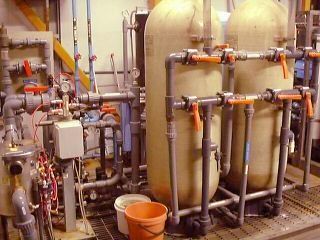
Fire is a big hazard in Antarctica. Everything is so dry and water is at a premium. So we have heaps of fire training and heaps of fire extinguishers around the base. This is only a small alcove filled with them. They are at the entrance to every room and also located inside every room. We use all types. Water filled and pressurised, co2 , powder and even some fire blankets. We used to have CFC extinguishers but got rid of them when they where found to be to dangerous to the environment (OZONE). The trick is to know which one to use and when. The small motor on the ground is called a Wajax and is linked to the main water sytem. In the case of an emergency it can be used to pump water through hoses to the scene of the fire or fill up sprinkler systems when the water runs out.
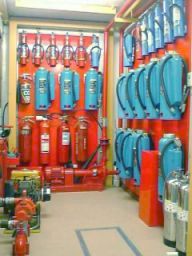
Talking about Fire stuff.... The plant rooms which are located in varios places around the base serve as localised areas of service control. In these little rooms you find controls for the local water, heating system, fire sprinkler system, electrical distribution boards, heating and ventilation controls etc... The big red cylinder you see beside electrical pannel is full of water. If a sprinkler head is activated then this tank will empty is contents (due to the air pressure supplied and regulator by the small blue compressed air cylinder beside it) through the sprinkler nozel as a front line defence to the fire as well as set off the fire alarm due to depressurisation. By then the other emergency actions will be underway and human intervention will continue with any means required to eliminate the threat. Everyone hated fire drills no mater how essential they where.

This is the Communications room where radios are monitored in the summer by dedicated comms people from the armed services who are trained in this field. They are the lifeline and first line of safety with groups and parties out in the field. Constant communication and "call in" is the only way to ensure there is no trouble out in the field. This room is manned 24 hours a day in the summer but in the winter when there are only base personal around and no field parties the comms are broad-cast over the Public address system so everyone has the ability to resopond to radio calls.
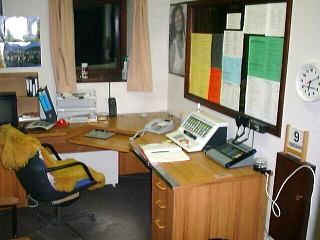
This is the sign out book. You are not alowed to leave the base without signing out where you are going and when you will be back ( you must also sign back in when you get back). It also shows who is on the fire crew ( the board above with tags)and who is located on the base according to sleeping accomodations (the small boxes on the paper), so if your on the fire crew and you want to go out then you have to ogranise for someone to take your place while you are away. The book is located next to the comms operator office in an area that also has the other administrative offices around it like the base managers, etc.
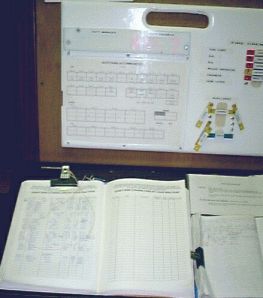
The audio visual / conference room with Large TV , video library, video editing suite, is a place where both summer and winter crews take time to relax if the room is not already being used for other more important buisness. It was amazing how quickly you see all the movies in stock and run out of fresh material to watch.
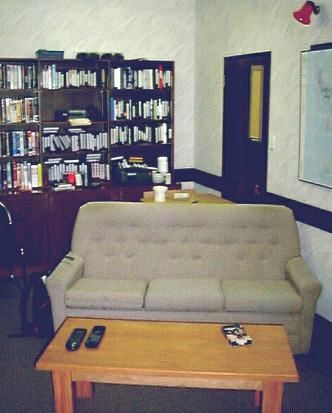
The Scott Base shop is a great place to buy little bits and pieces to make your stay on base a bit more comfortable or to buy those memorabilia that will let you remember the place when you eventualy go home. It caries evrything form bathroom and hyginee stuff to hats, toys, film, radios etc. Run by the armend services canteen in the summer it becomes a volentry thing in the winter. In this case Pauline was the person to look after the Store in our year.
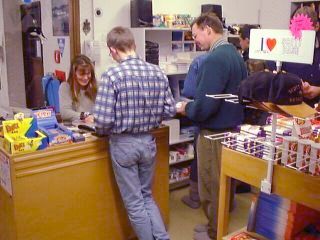
The Telecom room is full of racks which do all the communications and radio stuff. It also houses the base radio station and cd disk changer. It is a very important and expensive little room full of goodies for the technical sort of people. You would never go into this room armed with a powder fire extinguisher unless it was a last resort. CO2 or water where prefered front line defences. Powder has a nasty corrosive effect on equipment and would mean its eventual destruction. Powder is used as a last resort around technical equipment.
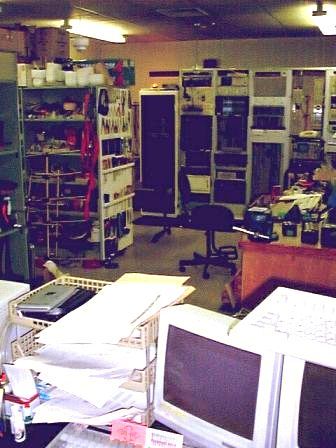
In the summer the mess area (eating area) is full of tables and chairs but in the winter the tables are reduced to a minimum and the couches, carpets and TV are moved into place so that people can relax in a more open style living environment instead of the audio visual room. It made for a very friendly and inviting living room. With quick access to the kitchen behind and the bar in front through the bifold doors you could relax in comfort after a hard days work. You may be wondering about the TV reception. There wasnt realy any. But the americans get a few channels throught thier satilite uplinks and in the process of transmiting it from one site to another thier was enough leakage for a very cunning radio tech to tap into it using a variety of thrown away decoders and an audio tunner section of an old walkman. I dont care what you say. It worked real well and it had the Americans baffled as to how he did it. This is not the case in the summer when everything is done by the book and this facility is not utilised . The TV itself is able to use the NTSC and PAL systems and takes a bit of geting used to depending on wether your watchig a video from New Zealand or a TV channel from the states.
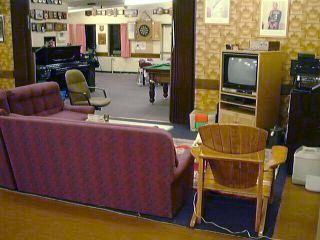
As you can see from the two pictures below this is the "Mess" from two slightly differnt perspectives. In the corner is what they call the small library (one of two, the other being up in the newly remodeled Qhut...another building we rebuilt in our year) another name for the small alcove is coffin corner. Maybe a remnant from the days when people where alowed to smoke in these areas.

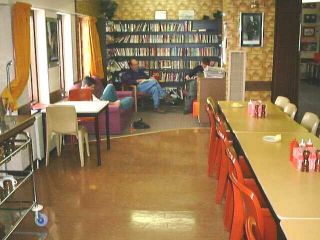
If you where in the far corner of the kitchen then look out into the mes then this is what you would see. Looking over the top of the Bain-maree and cook top. The food is served from the bain marees in a smorgasboard sort of arangement.
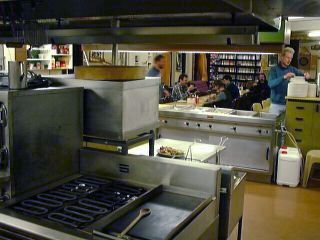
The bar was remodeled in the winter time. We hope peole liked what we did to it durring our year. It still need some living in when I left, but im sure the next few years will see them make it alot of people happy.
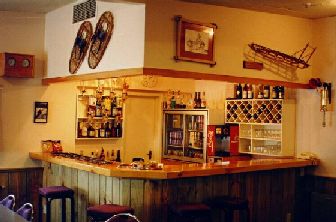
If you go into the hallway / Linkway outside the mess you will see all the winter over crew photos since the first days of Scott Base occupation. If you have spent a year on ice at Scott base then your photo will be there as well. The photo you see on the Winter Over Crew page (from my year) is the one that will be sitting on the wall in this corridore.
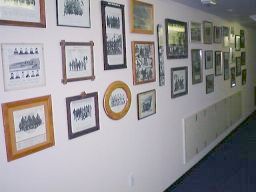
Alot of people ask about the laundry. Well it is all done in a small room with 4 big washing machines and 2 big driers.. as well as a couple of tubs. In the summer it gets a bit hectic trying to get your cloths washed. I understand that the facilities may have changed slightly with the building of a new ablutions and laundry block the year after I left. There was an option to use the dryers or a drying room which is located in the middle of the base and used to be an old linkway to a part of the old base which was demolished a many years ago.

Bedrooms. If your lucky you only had to share your room with one other person in the summer. Privacy in a small base is at a premium durring the summer. The window has shutters on it to block out the 24 hour sunlight in the summer and keep out the cold in the winter. A few of us got the carpenter to make up some shelving to store some extra nick knacks, but as a rule things where very cramped, and if you didnt have your own workshop or office to spread your stuff around the base then it made the problem even worse. Engineering staff (like myself, Mike and Jonathan) aslo had the joy of an alram panel with a shril piezo buzzer which had an anoying habit of going off in the middle of the night to indicate there was general engineering fault with something on the base. Much of the Base was semi automated, but if anything went wrong then things where set up to let you know about it.

The lab was where alot of the science geeks resided durring the day and all the internet surfers gathered at night. Hermione our science tech made sure things ran smoothly and that the scientist where well behaved and shared limited resources effectivly. Alot of the technical information gatherd in the field was procesed in this room and sent of to the world outsde. Much of the local wether information was gathered here and you would often see people checking the weather instruments here before going out into the field. There where a couple of public computers here for people to use for email or net surfing. I spent many late nights durring the end of summer and most of the winter in the chair you see trying to learn how to build a web site and then figuring out what to put onto it. This was also the computer that was used most often for digitial camera downloads.. (thousands of them) and was the first computer that this web site was originaly created on. Behind the desk you can see the siesmic instruments used to produce a hard copy of the earth movments and shakings. It was sensitive enough to pick up large ice flows bumping into land around antarctica or atomic testing ... But its paper print-out was desensitised and used mainly for triangulating earthquakes around the world. It was sobering to think that a few squigly lines on the paper could mean the death of hundreds of people somehwere in the world. The unit also did a digital copy which wasnt desensitised and which meant much more information was accesable for understanding the dynamics of our small planet. In this room where also instruments for geomagnetics (earths magnetic filed shift and strengths), ion particles in our atmosphere, ozone density instumnets etc...
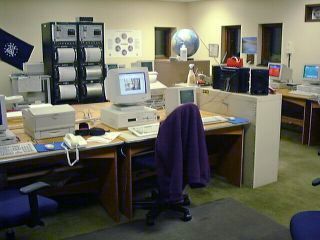
Below is the begining of the refurbishment of Q hut durring our winter on ice. Unlike all the other building on base, the Q hut doesnt use have crawl spaces around the inside of the floor and cieling. So it isnt a building inside a builidng like the other forms of construction now used. This means a higher thermal disipation rate and harder to heat evenly. The floor of this place used to squeek something wicked and nobody could get any sleep. So we gutted it, and it now has a mezanine floor above and space for about forty beds (most of which are fitted in already)below. The Library and study area are above. It required alot of on the job improvisation, heaps of teamwork and the ability to smile when things didnt always go the way we wanted them. It was only one of many projects going on that winter, and all things being equal, we think we did realy well. You may wonder what the big problem was. You try doing a reconstruction like this in the middle of antarctica with no way to get extra bits and pieces when you realise they whernt suppied with the original job. Having said that, it went realy well most of the time.
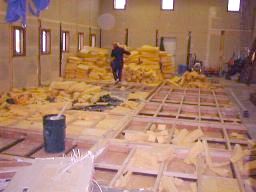
www.geocities.com/coolrunnernz/
9-3-01